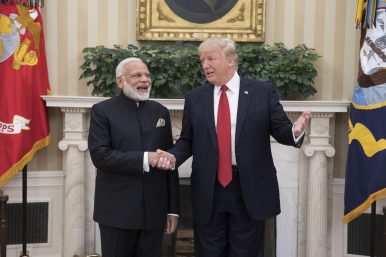By Aman Thakker
On May 23, Prime Minister Modi’s Bharatiya Janata Party won a resounding victory in India’s 2019 general elections. As Prime Minister Modi looks poised to take over India’s government for a second term, a key priority in his foreign policy will be continuing to advance relations with the United States. However, while Modi can expect some tangible deliverables early in his second term, he will also need to grapple with some serious challenges.
The Good
In Prime Minister Modi’s first term, security ties between the United States and India have been the key factor driving deeper collaboration between the two countries. Both countries have signed a number of defense agreements, conducted joint exercises, and have increased defense trade, with India committing to acquisitions of key U.S. platforms. As Prime Minister Modi begins his second term, he will see continued progress on all three fronts, underscoring the positive aspects of the relationship early on.
In the coming months, it is highly likely that both countries will announce the signing the Industrial Security Annex, as well as the last of the remaining “foundational agreements,” the Basic Exchange and Cooperation Agreement. India has also committed to expanding its fleet of P8-I maritime aircraft and will likely move forward with plans to purchase the Sea Guardian and the MQ-9 Reaper drones – all U.S. platforms. The United States and India will also conduct a new bilateral tri-services exercise, which was announced at the inaugural 2+2 dialogue between both countries. Prime Minister Modi can, therefore, look forward to several significant defense-related deliverables early in his second term.
The Bad
Despite the positive developments on the defense side, Prime Minister Modi will also need to grapple with souring relations with the United States on the economic front. The ongoing trade dispute between both countries, ranging from issues such as U.S. tariffs on steel and aluminum imports from India to India’s protectionist measures to raise custom duties, impose local content rules, and implement price controls will likely carry forward into Prime Minister Modi’s second term. Moreover, the announcement by the Trump administration of its intent to revoke India’s benefits under the Generalized System of Preferences is likely to further complicate the agenda, especially if the administration follows through with the revocation of benefits.
Another area of concern in U.S.-India ties for Prime Minister Modi in his second term is the Trump administration’s threats to the H-1B visa program, of which over 70 percent of beneficiaries are from India. President Trump has threatened to “end forever the use of the H-1B as a cheap labor program.” Although the program has not yet been terminated, denials of H1-B visa applications have spiked under the Trump administration, undermining a key pillar in India’s economic relationship with the United States. Therefore, Prime Minister Modi will have to tackle challenges on trade and skilled immigration vis-a-vis the United States in his second term.
The Ugly
Beyond these challenges, Prime Minister Modi in his second term faces two Damocles’ swords in the form of potential U.S. sanctions which could threaten India’s broader strategic relationship with the United States. The first of these sanctions emanate from India’s relations with Iran. The Trump administration announced in April 2019 that it would be ending sanctions exemptions for countries that import oil from Iran, effectively demanding India halt its oil exports from Iran. While India’s Ambassador to the United States has stated that the country had stopped all imports, this issue is likely to continue to be a thorn at the side of the U.S.-India relationship.
India also faces a significant threat of sanctions from its planned acquisition of the S-400 surface-to-air missile system from Russia. The purchase may trigger the applicability of the Countering America’s Adversaries Through Sanctions Act (CAATSA), which authorizes sanctions on any entities undertaking transactions with Russian defense or intelligence sectors. While the U.S. Congress did grant the president the authority to waive sanctions and Trump administration officials had indicated that a waiver for India was likely, reports have emerged that there has “been some walking back” on that assurance. With the biggest champion for the waiver and the relationship with India – former Defense Secretary James Mattis – out of the administration, the threat of CAATSA sanctions remains a major challenge in U.S.-India ties.
Following the 2019 general elections, Prime Minister Modi will return for a second term in office with a significant majority in the Lok Sabha. He will take office at a time when India’s relations with the United States are at a crossroads, where despite plenty of forward momentum, several threats can derail future progress. As Prime Minister Modi continues to prioritize advancing foreign relations with the United States, he will need to capitalize on the good, avoid the bad, and overcome the ugly to move the relationship forward.

No comments:
Post a Comment